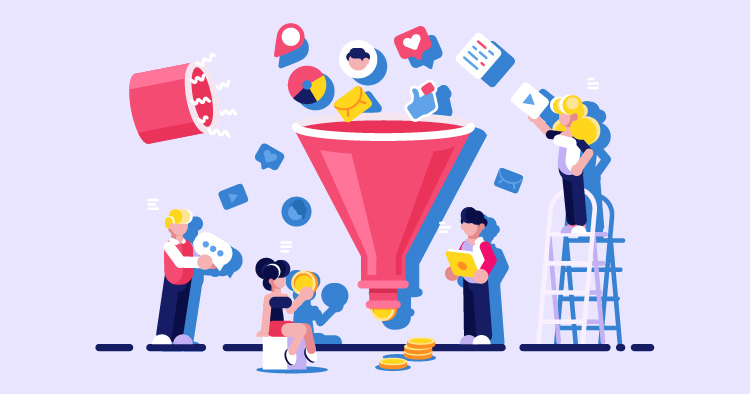When discussing the conversion of leads into customers, people often talk about marketing and sales funnels. Both funnels play crucial roles in customer acquisition, yet they serve different purposes and involve distinct strategies. Understanding the nuances between a marketing and sales funnel is essential for businesses aiming to optimize their conversion rates and streamline their customer journey. Companies can better align their marketing and sales efforts to guide potential customers from initial awareness to the final purchase decision by examining the stages and tactics of each funnel.
Defining the Marketing Funnel
The marketing funnel is like a roadmap that shows a potential customer’s path to buying something. Think of it as a journey that starts with someone just getting to know your brand and ends with them deciding whether to buy your product or service. It’s useful for businesses because it helps them determine their customers’ needs and wants at each step.
At the beginning of the funnel, you have ‘awareness,’ which is all about getting your product or service known. Next comes ‘interest,’ where you keep potential customers engaged by giving them exciting and helpful information. Finally, there’s ‘consideration,’ where you influence their thinking and help them decide your product is the right choice. Moving a customer smoothly through these stages can boost your chances of making a sale.
Understanding the Sales Funnel
The sales funnel is similar to the marketing one, but it’s more focused on turning someone interested in your product into a buyer. It begins with gathering potential customers, known as leads. Then, you nurture these leads by building a relationship with them, and finally, you reach the ‘conversion’ stage, where these leads turn into buyers.
Every step of the sales funnel is essential. Using different tactics and ways of talking to potential customers at each stage would be best. The primary aim is to gain their trust and show them your offering is valuable. Doing this well increases the likelihood of ending the process with a sale.
Key Differences Between the Marketing and Sales Funnels
Marketing and sales funnels serve the same goal: to make money for the business. However, they go about it in different ways. Think of the marketing funnel as getting people to know and become interested in the brand. It’s all about creating a buzz and getting many potential customers interested. This is where businesses use strategies like advertising, content marketing, and social media campaigns to get their name out there.
On the other hand, the sales funnel is more focused. Once marketing has brought potential customers to the door, the sales funnel is about making sure they buy something before they leave. Here, the conversation gets more personal. Sales teams might reach out directly to leads, offer demos, or negotiate deals to turn those leads into paying customers.
Aligning Marketing and Sales Efforts
The marketing and sales teams must be in sync for a business to succeed. Imagine a relay race: Marketing runs the first leg by attracting potential customers, and then they pass the baton to sales to finish the race and win the sale. When these two teams work together smoothly, customers don’t fall through the cracks, and the path from being interested in a product to buying it feels natural and easy.
Struggling with Digital marketing? Book Your Free Strategy Session!
- 30-Minutes Session
- Expert Insights
- Data-Driven approach
- Optimized Strategies for Your Goals
Marketing and sales can do a few things to make this teamwork happen. They can meet regularly to stay updated on each other’s activities, set shared objectives, and use software to see the customer’s progress from start to finish. It’s also crucial that they talk to each other clearly and frequently. This way, marketing campaigns can support sales targets, helping the company turn more leads into sales.
Choosing the Right Approach: Marketing or Sales First?
Deciding whether to focus on marketing or sales first can be tricky. If you start with marketing, you’re looking at spreading the word about your product or service to as many people as possible. This can be great for getting your brand out there, but seeing actual sales might take a while. If you zero in on sales immediately, you could see money coming in sooner. However, this might mean you’re not spending enough time getting your brand recognized on a larger scale.
Small businesses have to make a wise choice here. It’s all about what you need most, what you can afford regarding time and money, and who you’re trying to reach. If your business is brand new and you must make a name for yourself, you might lean towards marketing first. But if you’re when you need to keep the lights on and pay the bills, pushing for sales might be the way to go.
Optimizing the Marketing Funnel for Small Businesses
Making the most of your marketing funnel is all about connecting with your audience in the right way at the right time. You want to create content that speaks to them, whether they’re discovering your business or ready to buy. Search engine optimization (SEO) helps people find your content when they search online. Social media marketing and targeted ads can also get your message in front of the right eye.
It’s essential to match your content to the buyer’s journey. Consider your potential customer’s needs and how you can provide them at each step. Keeping in touch with them through emails that feel personal can keep them interested. And don’t forget to spread your efforts across different channels. This way, you can reach more people and keep your audience engaged no matter where they spend their time online.
Enhancing the Sales Funnel for Small Businesses
Small businesses can improve their sales funnel by connecting with potential customers. Small businesses can improve their sales funnel by engaging in networking events, forming partnerships with other companies, and creating offers directly appealing to the targeted audience. Once you’ve caught the interest of potential customers, it’s crucial to keep the conversation going. You can do this by regularly reaching out, providing more information about your products or services, and addressing questions or concerns they might have. This personalized attention can make people feel unique and more likely to buy from you.
Following up is also crucial. It ensures that your business stays in the minds of potential customers, so when they’re ready to make a purchase, they think of you first. To make these tasks more accessible and more effective, many small businesses turn to customer relationship management (CRM) systems. These systems help you keep track of your interactions with each customer, making it easier to provide the proper follow-up at the right time.
Integrating Marketing Automation in the Funnels
Marketing automation can be a game-changer for small businesses. It helps you handle routine tasks without a hitch, ensuring that messages and promotions reach customers right when they should. Plus, it gives each customer a personalized experience, even if you communicate with many people simultaneously.
With automation, you can guide leads through the buying journey smoothly, scoring them based on how likely they are to buy and delivering the right message at each funnel stage. There are many tools out there designed to help with this. For example, HubSpot, Marketo, and Mailchimp offer features that can help you automate your email campaigns, nurture leads, and understand your results through analytics. Choosing the right tool depends on the size of your business, what you need the tool to do, and the goals you’re trying to achieve. It’s about finding the perfect fit for your unique business needs.
Struggling with Digital marketing? Book Your Free Strategy Session!
- 30-Minutes Session
- Expert Insights
- Data-Driven approach
- Optimized Strategies for Your Goals
Measuring Success: Key Metrics for the Funnels
Understanding how well your marketing and sales funnels work is crucial for your business’s growth. You’ll need to look at several important metrics to get a clear picture. These include:
– Conversion Rates: This shows the percentage of people who take a desired action, like signing up for a newsletter or purchasing. It helps you gauge how compelling your funnel is to convince potential customers to move forward.
– Customer Acquisition Cost (CAC): This figure tells you how much you spend to acquire each new customer. Understanding this figure is vital to determining whether your marketing efforts are cost-effective.
– Customer Lifetime Value (CLV): This metric estimates the total revenue a business can expect from a single customer throughout their relationship. It’s a key indicator of long-term business health.
– Lead Generation Rates: This measures how many potential customers you attract. It’s essential for assessing the top of your funnel.
-Sales Cycle Length: This is the time it takes for a lead to go from initial contact to making a purchase. A shorter cycle usually means a more efficient sales process.
To make the most of these metrics, you must see how they relate to your business goals. For example, if acquiring customers is more expensive than what they bring in revenue, you might need to rethink your marketing strategies. Similarly, if it’s taking too long to close sales, it could be time to streamline your sales process.
Common Challenges in Implementing Funnel Strategies
When you’re working on your funnel strategies, you’re likely to run into a few common hurdles:
– Budget Constraints: Money is often tight, especially for smaller businesses, making it challenging to execute some strategies.
– Tool and Technology Selection: With so many options available, choosing the right ones for your needs can be overwhelming.
– Team Alignment: Ensuring your marketing and sales teams are working toward the same goals is easier said than done.
– Understanding Customer Behavior: Keeping up with why and how customers decide is a complex, ongoing task.
To overcome these challenges, set realistic goals aligning with your budget and business objectives. Focus on the most critical metrics that will give you actionable insights. Regarding tools, look for solutions that meet your needs and offer good value for money.
Training and clear communication are crucial to getting your teams on the same page. Also, remember to listen to your customers. Their feedback is invaluable for making informed adjustments to your strategies. You can navigate these challenges by staying flexible and responsive and keeping your funnels performing well.
Marketing Funnel vs Sales Funnel: Which Should You Prioritize?
Choosing between focusing on your marketing or sales funnel can be tricky. The marketing funnel is all about getting people interested and keeping them engaged. It’s where content, social media, and email campaigns shine. On the other hand, the sales funnel is where you get down to business–it’s about turning someone interested into someone who buys.
Your choice should align with what your business is trying to achieve now. If you’re starting, you might pour more energy into the marketing funnel to get your name out there. But if you’ve already got a good amount of people paying attention, it might be time to double down on the sales funnel to see more of those leads turn into sales.
Spreading the word and building interest is critical for a new business or a company launching a new product. That’s where a strong marketing funnel comes in. However, the sales funnel might take the spotlight to drive home those conversions for a business with a solid customer base and a well-known product.
In short, your focus–marketing or sales funnel–should align with what you need most: more awareness or conversions. It’s about understanding where your business stands and what your customers need from you.
Best Practices for Seamless Funnel Integration
To integrate your marketing and sales funnels smoothly, it’s essential to maintain consistent messaging throughout. This helps create a unified brand experience for your customers. Both teams should work towards shared goals to ensure that all efforts contribute to the same result. Using tools that work together for tracking and analytics can give you a comprehensive view of your performance.
Regular catch-ups and open lines of communication between the marketing and sales teams are vital. They help everyone stay on the same page and quickly address any issues. It’s also essential to keep refining your approach. Use data and customer feedback to make your funnels more effective and align them with your audience’s wants.
Evolving Funnel Strategies in a Dynamic Market
To keep up with a market that never stands still, your funnel strategies must be flexible and adaptable. Responding quickly to new trends, shifts in customer behavior, and technological advancements can give you an edge over the competition.
It’s essential to keep your skills sharp and your knowledge current. This means actively learning, watching what’s happening in your industry, and being willing to try out new methods and tools. Building a network with other professionals, attending relevant events, and constantly reviewing and tweaking your strategies based on their performance are crucial steps to staying ahead. Always be ready to adjust your sails to navigate the changing winds of the market.
Final Thoughts
Understanding the differences between marketing and sales funnels can significantly enhance a business’s approach to lead conversion. While the marketing funnel creates awareness and nurtures interest, the sales funnel focuses on converting that interest into tangible sales. Companies must integrate both funnels seamlessly to ensure a smooth transition for potential customers. By incorporating both funnels seamlessly, businesses enrich the customer experience and increase the likelihood of successful conversions and long-term loyalty. Businesses that master the interplay between these two funnels often enjoy sustained growth and a competitive edge.



